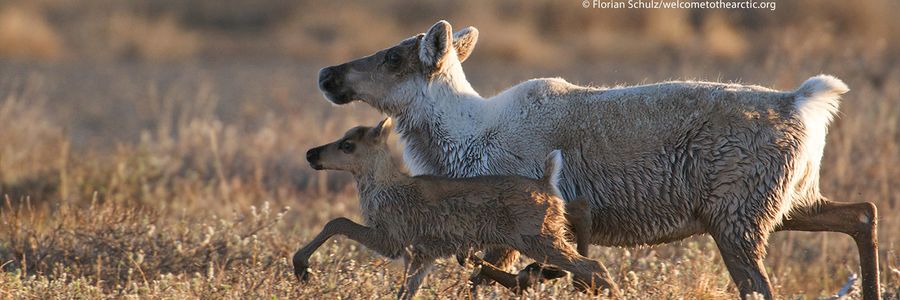Arctic National Wildlife Refuge
| KEY FACTS |
|
The Arctic National Wildlife Refuge is one of the most iconic and pristine landscapes in America. Its 1.5 million-acre coastal plain – the biological heart – is home to more than 250 species that migrate from all 50 states and 6 continents each year. The Porcupine Caribou Herd, a primary subsistence food source for the Indigenous Gwich’in people, migrates hundreds of miles each year to the coastal plain to give birth. Because of this, the Gwich’in refer to the coastal plain as “The Sacred Place Where Life Begins.”
Despite the sacred and wild beauty that survives in the Refuge, the Trump administration is barreling towards a drilling program in its fragile coastal plain. After the passage of the Tax Cuts and Jobs Act (H.R.1) in December, which included the Arctic Refuge drilling mandate, the administration and supporters in Congress have made it abundantly clear that they intend to rush through public processes this while the political winds are in their favor. Please see below for relevant legislation, talking points, fact sheets, and more on what we're doing to defend the Arctic Refuge.
Recent Legislative Activity
- H.R. 5911, Arctic Cultural & Coastal Plain Protection Act
- the bill to repeal the provision of the tax bill (H.R. 1) that mandates drilling in the Arctic Refuge and returns to status quo of no drilling
- H.R. 1, Tax Cuts & Jobs Act
- the overhaul of the American tax code came with a provision that mandated leasing in the coastal plain of the Arctic Refuge
- H.R. 1889/S.820, Udall-Eisenhower Arctic Wilderness Act
- landmark legislation that would designate the coastal plain as protected wilderness
Opportunities to Show Support
- Cosponsor H.R. 5911; H.R. 1889/S. 820 - email Logan Ferree (logan.ferree@mail.house.gov) in Rep. Huffman's office & Morgan Gray (morgan_gray@markey.senate.gov) to co-sponsor.
Talking Points
- Last year, a devastating provision was passed as part of the unrelated tax bill that mandates oil and gas development in the iconic Arctic National Wildlife Refuge. This damaging drilling provision mandates two lease sales within 10 years, each at least 400,000 acres in size, on the Refuge’s fragile coastal plain. Furthermore, this bill declared oil and gas as a purpose of the Arctic Refuge which has never before been the case, undercutting the integrity of the Arctic Refuge and setting a dangerous precedent for America’s entire National Wildlife Refuge System. The “Arctic Cultural and Coastal Plain Protection Act” would repeal this damaging provision and the stop the aggressive oil and gas development threat that is underway for the Arctic Refuge.
- The scars of 2-D seismic testing completed on the coastal plain in 1984 and 1985 are still visible 30 years later. Modern seismic exploration, however, is done using a 3-D technique that requires a much denser grid of trails. Just an EA will be insufficient- a full EIS is required for a proposal as impactful as seismic testing across the entire 1.6 million acre coastal plain. An EIS was conducted for the seismic performed in the 1980s.
- Seismic activities on the Coastal Plain will also adversely impact wildlife and their habitat, including polar bears. The Coastal Plain is the most important onshore denning habitat for polar bears, a federally listed species under the Endangered Species Act. Seismic activities have the potential to disturb polar bears during their denning season and to cause mothers to abandon their cubs. SAExploration’s seismic activities, which will extend from winter into spring, could also disturb other species like caribou and birds that return in the spring to the Refuge’s biological heart.
Fact Sheets
- The Trump Administration's Attempt to Open the Refuge to Seismic Exploration
- Leasing in the Coastal Plain
- Rep. Cole Amendment to FY19 Interior Appropriations Bill
Congressional Letters
- Letter from Senate Democrats Against NOI & Arctic Refuge Leasing, June 2018
- Letter from House Democrats Against NOI & Arctic Refuge Leasing, June 2018
- House Natural Resources Committee Democrats Letter to Secretary Zinke, April 2018
- Republican Letter Opposing Arctic Refuge Drilling in Budget Process, June 2017
- Bicameral Letter to Secretary Zinke Opposing Secretarial Order 3352, June 2017
Public Letters
- Guide & Outdoor Recreation Professional Letter, June 2018
- Athlete Letter, June 2018
- Gwich'in Steering Committee Letter, May 2018
- Investor Letter, May 2018
Maps
- ASRC Lands in the Arctic Refuge
- Porcupine Caribou Herd Migration Route Map - Gwich'in Steering Committee
- Oil & Gas Leasing in the North Slope
- Arctic Values Map
Reports & Previous Attempts to Drill
